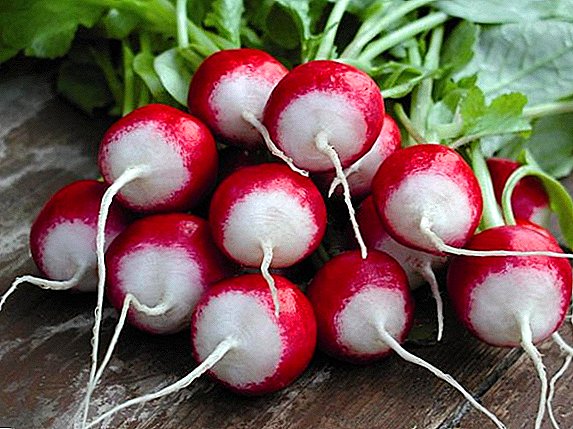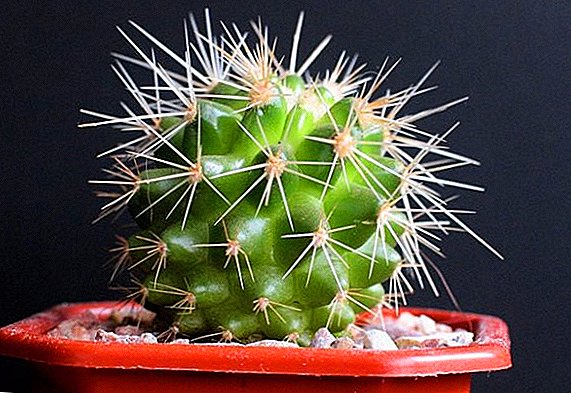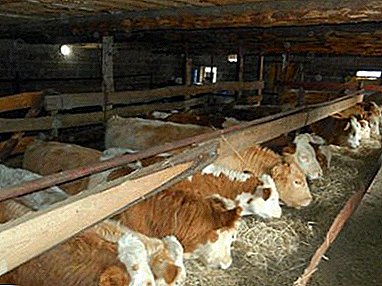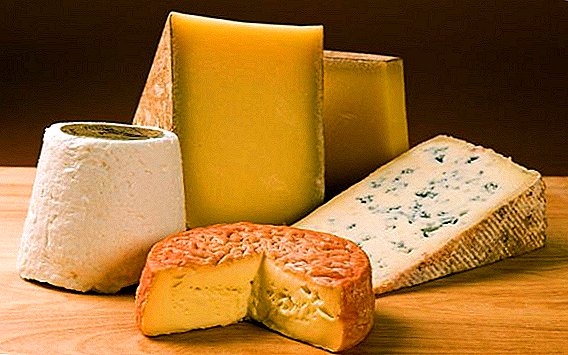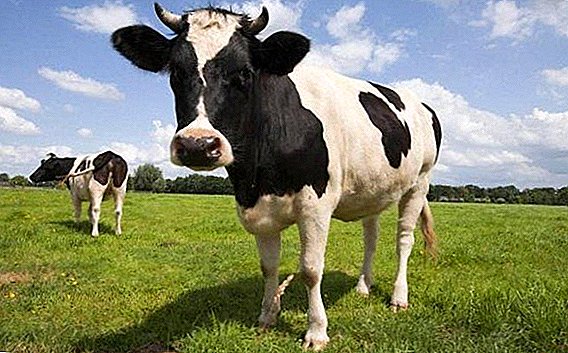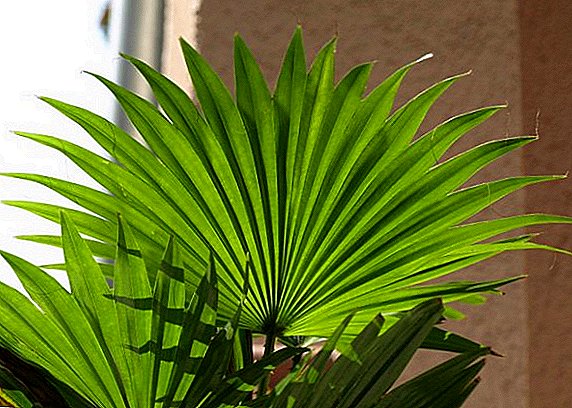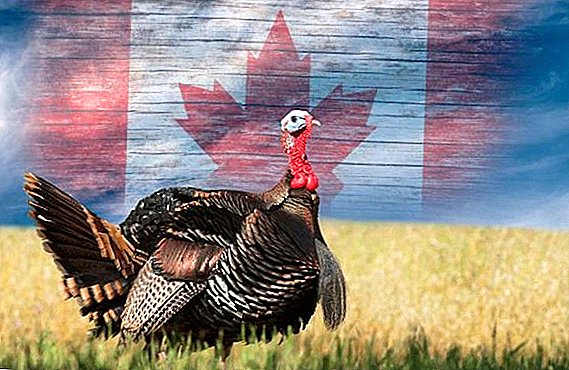 Among broiler-type turkeys, the Canadian wide-breasted are distinguished by their very large size and majestic posture, and if we also take into account the relatively low demands on the conditions of detention, we get just the ideal candidates for breeding. It is worth getting acquainted with the characteristics of these birds more thoroughly.
Among broiler-type turkeys, the Canadian wide-breasted are distinguished by their very large size and majestic posture, and if we also take into account the relatively low demands on the conditions of detention, we get just the ideal candidates for breeding. It is worth getting acquainted with the characteristics of these birds more thoroughly.
Description and Features
 Canadian wide-breasted turkeys have a beautiful white or black and white plumage, with light stripes mainly on the tail.
Canadian wide-breasted turkeys have a beautiful white or black and white plumage, with light stripes mainly on the tail.
The tail is big, fan-shaped, beautifully straightening at the moment of excitement of the bird, legs are long and strong, however, like many other representatives of the turkey world.
The main distinguishing feature of the breed - a wide and dense chest, from which the rest of the body begins to taper backwards. It is quite possible to call the head standard: it is sheet, with skin growths and a "bag-like" chin. When describing the productive characteristics of this bird, it is worth highlighting its precocity, which is also a significant feature.
Did you know? Turkeys are known for their pugnacious temper, but even they have their own “code of honor.” So, if the enemy surrendered, lay down on the ground and stretched his neck, he can consider himself saved, he is not touched.
Performance Indicators
Despite the meat direction of Canadian wide-breasted turkeys, they can boast quite good indicators of egg production.
In general, their productivity is as follows:
- live weight: turkeys about 30 kg, turkeys - 15-20 kg;
- slaughter age - 3 months (it does not make sense to keep birds for meat longer);
- the beginning of egg-laying - from 9 months;
- egg production - up to 90 light brown or beige eggs per year, 70-80 g each;
- chick survival rate - up to 93%.
 Under favorable conditions of maintenance, egg production rates can be increased, and the onset of egg production is accelerated.
Under favorable conditions of maintenance, egg production rates can be increased, and the onset of egg production is accelerated.
It is interesting to read about the beneficial properties and consumption of meat, liver, turkey eggs.
Character and instinct nasizhivaniya
Both females and males of the described breed do not have a bad temper, therefore, they behave like most of their relatives. At the same time, the instinct of incubating turkeys is much more developed than in some other breeds, so in order not to bring the bird to exhaustion (sitting on a nest, it forgets about food), you should put a trough and a drinker next to the nest.
In the event that hatching is not yet planned, it is better to place all the nests in the well-lit area of the house so that the turkey is not so comfortable with hatching eggs. The best hens are birds at the age of two, but the activity of the males is most noticeable at the age of 3-4 years.
Important! Maximum hatchability can be achieved from eggs that have lain before laying for no longer than four days.
Conditions of detention
When arranging a turkey breeder, it is necessary to take into account all the same parameters as in the construction of any other house, only indicators of lighting, temperature, humidity or even the size of the room in this case will be individual. 
Requirements for the room
Given the considerable size of the birds, when selecting a room for the house should be calculated so that each turkey turned out at least 1-1.5 square meters. m free space, otherwise the birds will feel cramped and will not be able to develop normally.
The optimum temperature in the turkey hens should be maintained at + 5 ... +30 ° С, and when breeding turkey poults, stable indicators must be consistent with + 20 ... +25 ° С.
Canadian wide-breasted turkeys are very fond of light, and therefore the windows in the house should be rather big, providing a sufficient amount of sunlight. In winter, additional lighting can be arranged so that the light day is at least 14 hours.
Learn more about building your own turkey barn.
Perches placed at a height of one meter from the floor surface, and dry hay or straw is often used as litter, which is the most profitable and correct solution. Dampness and drafts are a taboo for growing Canadian wide-breasted turkeys, which means that regular cleaning of damp bedding and ventilation of the house during turkey walking are indispensable conditions for their well-being.
So that the birds do not freeze in their hands, the floor in the house can be made of wood or simply cover the concrete base with sheets of plywood, pre-treated from rotting. A layer of hay or straw is laid over them. In particularly harsh climatic regions, with the arrival of stable frosts, it will be necessary to equip a heating system in the house.  For the organization of the litter layer with a thickness of 12-15 cm are ideal:
For the organization of the litter layer with a thickness of 12-15 cm are ideal:
- corn stalks;
- dried hay;
- sawdust;
- chaff.
Before laying the material on a concrete base, it is recommended to treat the floor with quicklime at the rate of 500-800 g per 1 square meter. This measure will protect birds from possible infections and bacteria.
Did you know? The characteristic turkey curdling, which is heard far outside the private courtyards, comes only from the males, while the females are very quiet and "silent" birds.
Aviary for walking
Despite the fact that Canadian wide-breasted turkeys belong to a heavy broiler type, they need to walk no less than other inhabitants of the monastery. Of course, for the most part this concerns juveniles, but also adult birds should have access to grass and sun. Arrangement of the enclosure can be organized directly on the street, placing it on the ground. This is where turkeys will spend most of their time in the summer and sometimes stroll in the winter.  Required attributes of a good aviary should be canopy and located inside the feeders with drinkers, and as a material for fencing free-standing space, a mesh with medium cells is ideal. To provide the birds with the maximum amount of vitamins, it is useful to sow the territory with alfalfa, vetch, clover, oats or peas.
Required attributes of a good aviary should be canopy and located inside the feeders with drinkers, and as a material for fencing free-standing space, a mesh with medium cells is ideal. To provide the birds with the maximum amount of vitamins, it is useful to sow the territory with alfalfa, vetch, clover, oats or peas.
Learn how to make your own turkey drinkers.
The diet of adult turkeys
Features diet "Canadians" is largely dependent on the age of the bird and the time of year. It is no secret that chicks, like adults, need more vitamins during the cold season, which they can get only with food. This feature should be considered when drawing up a daily menu of birds.
Summer
Feeding turkeys should be three times a day and as balanced as possible, for which you can use feed mixtures and grain. In addition, birds are very fond of corn and barley, so they should be present in the bird menu. Dry food is recommended to be given in the evening, and wet and dry mash in the morning and afternoon, in addition to which turkeys will consume the greens growing on the range.  If there is not much grass in the selected area, then it will be useful to give the birds green onions, dandelions and carrot tops, along with the main feed, after having ground the greens beforehand.
If there is not much grass in the selected area, then it will be useful to give the birds green onions, dandelions and carrot tops, along with the main feed, after having ground the greens beforehand.
Important! Along with food, birds should always have fresh water, and both in the house and in the area of walking. The fluid must be changed daily, while at the same time washing out the drinkers well.
In winter
In the cold season, the menu of all poultry is more limited, because there is no access to the main source of vitamins - greenery. In order to somehow compensate for this deficiency, Canadian wide-breasted turkeys are given out vegetables harvested in the fall, including especially valuable will be:
- cabbage;
- beet;
- carrot;
- grated squash (rarely for adults).
All of them are perfectly combined with dry and wet masters, so they can be used at any time. In addition, it is appropriate for winter feeding and harvested from the summer hay, lime and birch brooms, as well as fees from the leaves of fruit trees, pre-soaked in water. No less useful will be shredded pine needles, which is an excellent prevention of many diseases.  However, in order for the plant to bring only benefit, it is advisable to use only winter preparations, since in spring a large amount of unwanted essential oils appear in the needles. Get a juicy and tender turkey meat will help a large number of succulent feed in the diet, while reducing the proportion of dry mixes.
However, in order for the plant to bring only benefit, it is advisable to use only winter preparations, since in spring a large amount of unwanted essential oils appear in the needles. Get a juicy and tender turkey meat will help a large number of succulent feed in the diet, while reducing the proportion of dry mixes.
Learn more about keeping turkeys in the winter at home.
Growing turkey poults at home
Reproduction of Canadian wide-breasted turkeys at home is possible, but difficult, since the male is always much heavier than the female. That is why many poultry farmers resort to artificial insemination, but the task of breeding chicks falls on the shoulders of a turkey or an electric device - an incubator. Given that the "artificial mother" is not in every household, consider all the stages of breeding chicks using a hen.
Choice of hen
The turkeys of this breed, as well as many other breeds, are caring mothers, who often forget to eat, hatching eggs. Determining the most responsible of them is not difficult: the one who does not leave the nest the longest is the best option for this role.  For the first time, the birds express a desire to become mothers closer to the year, although the “Canadians” begin to rush already at 9 months. Depending on the experience of the turkey, you can put from 15 to 22 eggs under it, and to keep them well warmed, you place the feeder and the drinker next to the nest. Do not forget about short walks, because even the hen needs to warm up and relieve need. If your mom does not want to leave the nest, try to lure it with cabbage leaves, which these birds simply can not refuse.
For the first time, the birds express a desire to become mothers closer to the year, although the “Canadians” begin to rush already at 9 months. Depending on the experience of the turkey, you can put from 15 to 22 eggs under it, and to keep them well warmed, you place the feeder and the drinker next to the nest. Do not forget about short walks, because even the hen needs to warm up and relieve need. If your mom does not want to leave the nest, try to lure it with cabbage leaves, which these birds simply can not refuse.
Read also about the breeds of broiler turkeys (grade maker, Victoria, Big 6) and their content.
Nest
The nest can be constructed from usual spacious wooden box. It is well washed out beforehand and dried, after which a thick layer of dry hay is placed on the bottom. Then lay out the eggs, which are sprinkled on top of wood ash and slightly sprayed with cologne. Alcoholic liquid briefly scare away insects (ticks, fleas or beetles).
Alternatively, you can organize brick perch. First, warm fabric is laid out on the site of the future nest (for example, several layers of burlap), and a row of bricks are placed on top of it, but so that a recess remains between them. Straw or hay is placed in it and it is well tamped to place eggs on top. If there are several cavities (sockets), they should be separated from each other with sheets of cardboard.  In some cases, turkeys do not want to sit on the eggs in the place prepared for them and are looking for a suitable nest for themselves. We'll have to convince the bird in the correctness of your choice and for some time cover it with an inverted basket or other similar product. After a few days, the hen will stop attempting to escape and will remain sitting in the prepared place.
In some cases, turkeys do not want to sit on the eggs in the place prepared for them and are looking for a suitable nest for themselves. We'll have to convince the bird in the correctness of your choice and for some time cover it with an inverted basket or other similar product. After a few days, the hen will stop attempting to escape and will remain sitting in the prepared place.
Important! Under no circumstances can the bottom of the nest be metal. If the turkey starts to bury eggs in the hay (this happens quite often), then on a metal base they can be supercooled.
Laying and hatching eggs
As we mentioned earlier, 15 eggs are enough for a young henwhile under the experienced "mommy" you can lay 22 eggs. However, this is not all the requirements for the process of laying and further incubation. No less important point will be correct selection of eggs. Thus, the selected specimens should be of medium or slightly larger than average size, even light shell and the correct shape. Any flaws in appearance should be a reason for culling, since it is impossible to predict which chicks will be obtained from them. If all conditions of incubation are fully met, the offspring will appear after 27-32 days. 
Care for the young
If the little turkey poults have a mother, then the farmer will have much less trouble, but in any case it is worth knowing about some of the rules for caring for the turkeys.
Important! Chicks of Canadian wide-breasted turkeys are prone to intestinal ailments, therefore special requirements are placed on their diet and timely cleaning of the room (it is always necessary to monitor the purity and quality of food).
They can be arranged in the following list:
- in the first week of chick life, the temperature in the room should be at + 32 ... +33 ° C (especially if there is no turkey with turkey poults), in the second - at + 26 ... +27 ° C, and in the third - + 22 ... +23 ° C;
- The regular feeding of babies in the first week - 8-10 times a day, and starting from the 8th day of life, the number of feedings can be gradually reduced;
- water should be replaced in the open-air cage at least 4-5 times a day, and it is good to add a weak solution of potassium permanganate to the liquid (in the first hours of babies' life, it is desirable that the drinking temperature corresponds to +24 ° C);
- residues of food and excrement should be removed as often as possible, since the soured mixture leads to the rapid reproduction of microorganisms dangerous for birds and diseases of birds;
- as the scallops develop and grow, turkey poults can be transferred to adult food.

What to feed
The first meal of turkey chicks is carried out only 12-15 hours after the birth, because at first they are still very weak and will not be able to peck food. But if you tighten with this, then the kids will begin to peck on the litter, and it's good if it turns out to be fresh and clean. At first, it is most practical to feed poults with special "baby" feed intended for the young of any domestic poultry.
We advise you to read about the breeds of white turkeys wide-chest and bronze wide-chest.
It includes all the necessary vitamins and elements for a growing body, and its finely granulated form greatly facilitates the use of food by chicks. If there is no special mixture, you can cook it yourself, just by mixing several boiled eggs with dry, well-crushed cereals. After a few days, a mixture of grain flour can be used for feeding the turkey poults, the main component of which will be high-nutritional corn flour.  Later (starting around the third week of chick life), you can add some other ingredients to the wet mash: finely chopped cereal grains, fish oil, cottage cheese, fresh greens, and later fresh milk.
Later (starting around the third week of chick life), you can add some other ingredients to the wet mash: finely chopped cereal grains, fish oil, cottage cheese, fresh greens, and later fresh milk.
Important! Adolescent poults in addition to the basic ration should be placed in the house a separate container with mineral additives (shells, gravel, chalk), and for the prevention of various ailments dandelions, yarrow and clover will be useful.
Advantages and disadvantages
Canadian wide-breasted turkeys have quite a few advantages, thanks to which they are valued by poultry farmers. First of all, it is:
- tasty and unusually tender meat, which retains its high taste qualities up to six months of age;
- rapid growth and maturation (perfect slaughter age - 3 months);
- comparative simplicity to the conditions of detention;
- well-developed maternal instinct of turkeys;
- high percentage of hatchability of chickens (up to 93%).
As for deficiencies, they are a bit smaller, but despite this, ignoring these disadvantages will not work:
- due to existing mating problems, artificial insemination may be necessary;
- young birds are very sensitive to temperature conditions and at low values can hurt;
- For the well-being of birds, the grass, at least dried, should be in their diet all year round.
 Otherwise, the representatives of the breed are unpretentious and can become a real decoration of the yard, and this is not to mention the high rates of productivity.
Otherwise, the representatives of the breed are unpretentious and can become a real decoration of the yard, and this is not to mention the high rates of productivity.
Canadian wide-breasted turkeys are an excellent breed of broiler breeding, which is hard not to notice, having read its characteristics more closely, therefore, if you have not yet decided on your choice, we recommend paying attention to these birds.



